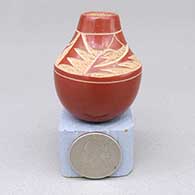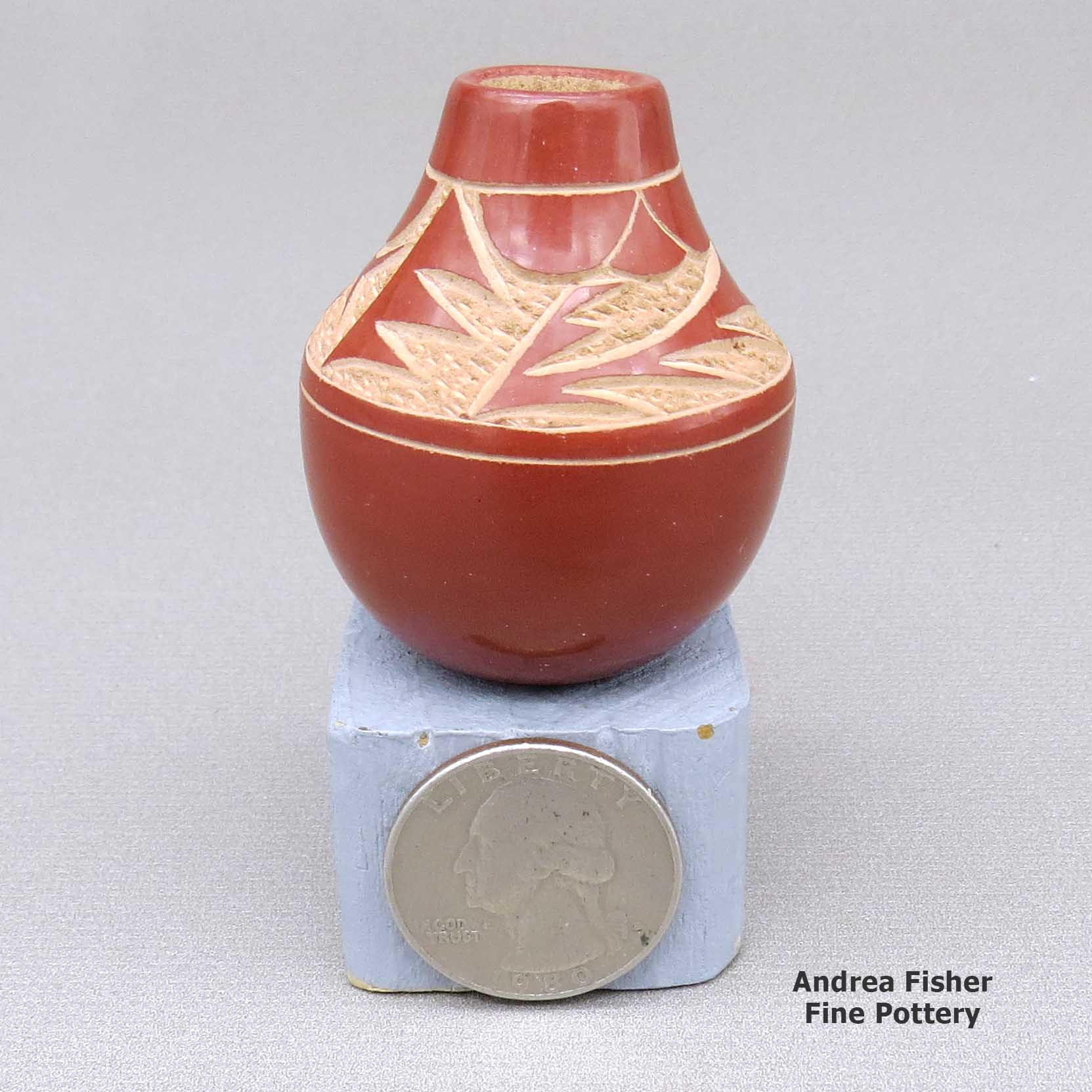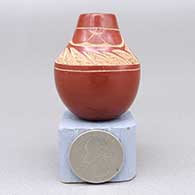
Art Cody
Haungooah
Kiowa, married into Santa Clara

The grandson of renowned Kiowa medicine man and scout James Haungooah, Art Cody was born in Lawton, OK in April 1943. James Haungooah was also famous for his ledger drawings of life on the southern Great Plains. The name Haungooah means "silverhorn," or "sunlight reflecting off a buffalo horn" in the Kiowa language.
Art met Martha Suazo in Dallas where she was attending school and he was stationed at Fort Hood. They got married in 1972 and, following Puebloan tradition, he moved to her home at Santa Clara Pueblo. They began making pottery together and their son Dean was born that same year.
Art went to school at Cameron College in Lawton, OK, the University of New Mexico and the Institute of American Indian Arts, graduating from IAIA with an Associate of Fine Arts degree. He learned pottery making, silversmithing, jewelry making, painting, stone sculpture and bronze making.
Born in 1947, Martha Suazo was a daughter of Joe and Santanita Suazo, both acclaimed potters from Santa Clara. Martha learned how to make pottery from her mother and she taught the basics to Art. Usually, when they were working together, Martha would make the piece, Art would sand it, Martha would polish it, then Art would fire it and do the sgraffito work, carving and etching his designs into the surface of the piece. Over time he graduated to adding inset stones, silver, pipestone, mother-of-pearl, precious stones, beaded medallions and strands of heishe beads, multiple slip colors and two-tone firings.
Art and Martha's pottery was a mix of traditional and contemporary styles and designs and they were an immediate sensation in the Native American pottery world. They offered a unique fusion of Santa Clara and Kiowa designs, usually on miniature pieces. They did make a few larger pieces but as Art once said, "I can make twice the amount of money by making miniatures. There's a bigger demand for miniatures, and they're not that time consuming, because there's a smaller area to work with. The larger pieces you put more time into it, and then if they do sell you've got to sit back and wait for a buyer to come in."
Art and Martha took part in exhibits like Santa Fe Indian Market, the Heard Museum Guild and Indian Art Fair, Seven Families in Pueblo Pottery and a 1979 tour in Europe put together by Pierre Cardin.
Sadly, in 1981 Martha was struck and killed by a bolt of lightning while she was walking around at Puye Cliff Dwellings (an ancestral home of the Santa Clara people). In 1983, Art married Brenda Tafoya (sister of Ken Tafoya, Ray Tafoya and Paul Speckled Rock). In September 1985, Art, Brenda and their infant son Scotti died in a single-vehicle car accident.
Art and Martha's work is on display in museums such as the Heard Museum in Phoenix, AZ, the Denver Art Museum, the Eiteljorg Museum of American Indians and Western Art in Indianapolis, the Museum of Indian Art and Culture in Santa Fe, NM, and the Smithsonian's National Museum of the American Indian.
Most of their pieces were signed by Art alone, usually with "Haungooah" somewhere in the name. In the early 1980s he signed a few pieces using his initials and the outline of a fish. There are a very few pieces signed by both Art and Martha and even fewer pieces signed by Martha alone (and all seem to have been miniatures). Their son, Dean Haungooah, carries on today making the shapes and designs made popular by his parents.
Some of the Awards Art and Martha Earned
- 1971 - First Place, Heard Museum Guild Indian Art Fair & Market
- 1976 - First Place, Heard Museum Guild Indian Art Fair & Market
- 1977 - Second Place for a pottery lamp, Santa Fe Indian Market
- Second Place for a miniature bowl, Santa Fe Indian Market - 1978 - Third Place for a miniature sgraffito pot, Santa Fe Indian Market
- 1979 - Best of Division, First Place for a sgraffito miniature jar, Santa Fe Indian Market
- 3rd Place for a sgraffito seed pot, Santa Fe Indian Market - 1980 - Second Place for a miniature sgraffito jar, Santa Fe Indian Market
- 1983 - Second & Third Place for non-traditional, new forms, innovations, Santa Fe Indian Market
100 West San Francisco Street, Santa Fe, New Mexico 87501
(505) 986-1234 - www.andreafisherpottery.com - All Rights Reserved

Santa Clara Pueblo

Ruins at Puye Cliffs, Santa Clara Pueblo
Santa Clara Pueblo straddles the Rio Grande about 25 miles north of Santa Fe. Of all the pueblos, Santa Clara has the largest number of potters.
The ancestral roots of the Santa Clara people have been traced to the pueblos in the Mesa Verde region in southwestern Colorado. When that area began to get dry between about 1100 and 1300, some of the people migrated to the Chama River Valley and constructed Poshuouinge (about 3 miles south of what is now Abiquiu on the edge of the mesa above the Chama River). Eventually reaching two and three stories high with up to 700 rooms on the ground floor, Poshuouinge was inhabited from about 1375 to about 1475. Drought then again forced the people to move, some of them going to the area of Puye (on the eastern slopes of the Pajarito Plateau of the Jemez Mountains) and others to Ohkay Owingeh (San Juan Pueblo, along the Rio Grande). Beginning around 1580, drought forced the residents of the Puye area to relocate closer to the Rio Grande and they founded what we now know as Santa Clara Pueblo on the west bank of the river, between San Juan and San Ildefonso Pueblos.
In 1598 Spanish colonists from nearby Yunque (the seat of Spanish government near San Juan Pueblo) brought the first missionaries to Santa Clara. That led to the first mission church being built around 1622. However, the Santa Clarans chafed under the weight of Spanish rule like the other pueblos did and were in the forefront of the Pueblo Revolt of 1680. One pueblo resident, a mixed black and Tewa man named Domingo Naranjo, was one of the rebellion's ringleaders. When Don Diego de Vargas came back to the area in 1694, he found most of the Santa Clarans on top of nearby Black Mesa (with the people of San Ildefonso). An extended siege didn't subdue them so eventually, the two sides negotiated a treaty and the people returned to their pueblo. However, successive invasions and occupations by northern Europeans took their toll on the tribe over the next 250 years. The Spanish flu pandemic in 1918 almost wiped them out.
Today, Santa Clara Pueblo is home to as many as 2,600 people and they comprise probably the largest per capita number of artists of any North American tribe (estimates of the number of potters run as high as 1-in-4 residents).
Today's pottery from Santa Clara is typically either black or red. It is usually highly polished and designs might be deeply carved or etched ("sgraffito") into the pot's surface. The water serpent, ("avanyu"), is a traditional design motif of Santa Clara pottery. Another motif comes from the legend that a bear helped the people find water during a drought. The bear paw has appeared on their pottery ever since.
One of the reasons for the distinction this pueblo has received is because of the evolving artistry the potters have brought to the craft. Not only did this pueblo produce excellent black and redware, several notable innovations helped move pottery from the realm of utilitarian vessels into the domain of art. Different styles of polychrome redware emerged in the 1920's-1930's. In the early 1960's experiments with stone inlay, incising and double firing began. Modern potters have also extended the tradition with unusual shapes, slips and designs, illustrating what one Santa Clara potter said: "At Santa Clara, being non-traditional is the tradition." (This refers strictly to artistic expression; the method of creating pottery remains traditional).
Santa Clara Pueblo is home to a number of famous pottery families: Tafoya, Baca, Gutierrez, Naranjo, Suazo, Chavarria, Garcia, Vigil, Tapia - to name a few.
100 West San Francisco Street, Santa Fe, New Mexico 87501
(505) 986-1234 - www.andreafisherpottery.com - All Rights Reserved

Santa Clara
$ 275
cjsc3f157
Miniature red jar with a sgraffito raincloud and geometric design
1.5 in L by 1.5 in W by 1.75 in H
Condition: Very good, normal wear
Signature: Haungooah Haungooah
Date Created: 1975
100 West San Francisco Street, Santa Fe, New Mexico 87501
(505) 986-1234 - www.andreafisherpottery.com - All Rights Reserved

Miniatures
Most people think that miniature pottery is something new in the world of Native American pottery. In reality, archaeologists have found miniature pottery in the remains of ancient ruins in Chaco Canyon, Mesa Verde, across eastern Arizona, southern New Mexico and south to the Paquimé and Casas Grandes region in northern Mexico. Archaeologists working in the eastern US have found miniature pottery spread across Early Woodland Culture sites, too, dated up to 1700 years ago.
We have no idea as to why the ancients created miniature pottery but there's lots of speculation. Perhaps it was made as toys for children. Perhaps it was made by children learning to make pottery, and as their expertise grew, the size of their pieces grew, too. Perhaps it was made and placed in a firing pit as a good luck charm, hoping that other pots being fired in the pit would survive the firing process and not crack or break. Perhaps it was made for some ceremonial purpose we have no possibility of knowing. We do know that in North America, almost every pottery-making group of ancients made miniature pottery. They decorated it, too, just like the full size pottery the women of the time were making.
As the rebirth of traditionally made Native American pottery has unfolded over the last century, research into the ancient forms, styles and designs has also brought the miniature back into focus. There are more than a few potters these days making tiny gems again, similar to and, at the same time, more refined than the products of the potters of prehistory. And while some are still being made by children learning as they grow up, many more are being made by established adult potters. Some have made their entire careers around the making of miniatures while others sometimes make a few miniatures to complement the full range of forms and styles of full size pieces they make.
100 West San Francisco Street, Santa Fe, New Mexico 87501
(505) 986-1234 - www.andreafisherpottery.com - All Rights Reserved

Santanita Suazo Family Tree
Disclaimer: This "family tree" is a best effort on our part to determine who the potters are in this family and arrange them in a generational order. The general information available is questionable so we have tried to show each of these diagrams to living members of each family to get their input and approval, too. This diagram is subject to change should we get better info.
- Shirley Duran & Joseph Duran (Tesuque)
- Aaron Duran (Tesuque, 1969-1994) & Tina Gasper (Zuni)
- Koty Duran (Tesuque, 1993-)
- Megan Duran
- Aaron Duran (Tesuque, 1969-1994) & Tina Gasper (Zuni)
- Martha Haungooah (-1981) & Art Cody aka Haungooah (Kiowa)(1943-1985)
- Dean Haungooah (1972-)
- Margie Naranjo
- Candelaria Suazo
- Mae Tapia (1952-2015) & Frank Tapia
- April Tapia & Joseph Gutierrez
- Ira Tapia & Morena Tapia
Santanita Suazo & Joe Suazo
(505) 986-1234 - www.andreafisherpottery.com - All Rights Reserved





